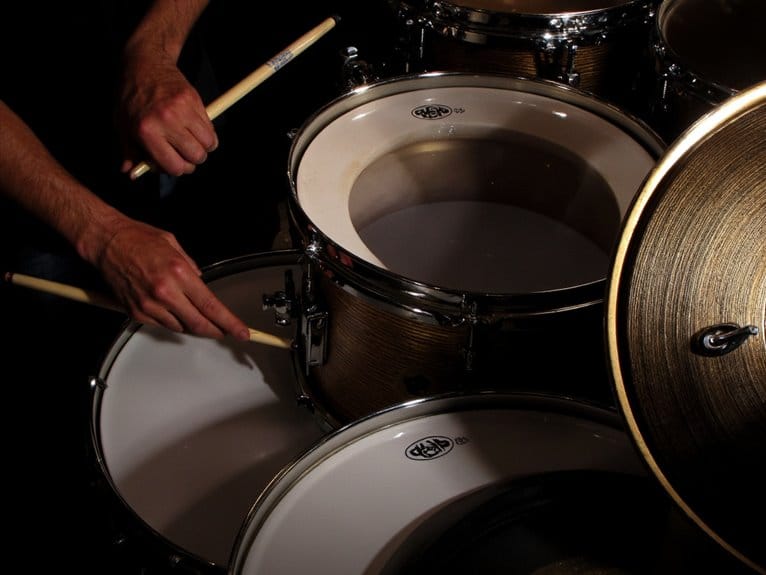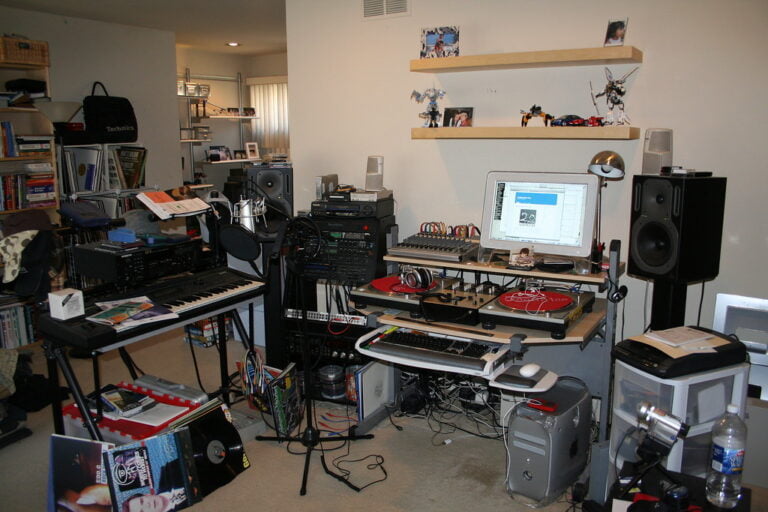Drum Tuning Fundamentals: Intervals and Techniques
You’ll achieve professional drum sounds by mastering interval selection and head tensioning techniques that transform your kit into a cohesive musical instrument. Start with tighter pitch intervals of two semitones for larger configurations, while smaller setups accommodate wider three-to-four semitone spacing without frequency crowding. Use a star pattern for systematic lug adjustment, ensuring equal tension across all mounting points, then balance your batter and resonant heads with the batter tuned first. Electronic tuners provide objective frequency readings and memory functions, while genre-specific approaches—like low-tuned toms for rock or higher-pitched drums for jazz—require different head tension relationships to achieve distinct sonic signatures that prevent frequency masking and maintain clarity throughout your entire kit’s pitch hierarchy.
We are supported by our audience. When you purchase through links on our site, we may earn an affiliate commission, at no extra cost for you. Learn more.
Notable Insights
- Use perfect fourths or fifths for tom intervals in larger setups, while smaller configurations allow wider three to four semitone spacing.
- Apply star pattern tensioning across lugs with equal tension to achieve consistent pitch and enhanced drum resonance quality.
- Tune batter head first, then adjust resonant head slightly tighter for attack or looser for sustain and pleasing intervals.
- Electronic tuners provide precise frequency readings, memory functions, and filter modes to isolate drum sounds in noisy environments.
- Adapt tuning approaches by genre: low-tuned toms for rock/metal, higher-pitched drums for jazz, moderate tuning for pop/fusion styles.
Selecting Musical Intervals for Different Kit Configurations
When you’re setting up intervals across your drum kit, the number of toms you’re working with fundamentally shapes how you’ll approach pitch relationships, since larger configurations demand more strategic frequency management than smaller setups.
With smaller kit configurations, you’ve got the luxury of using wider musical intervals between your drums—maybe three or four semitones—because you’re not cramming multiple toms into a limited frequency range.
However, when you’re dealing with five or more toms, you’ll need to tighten those intervals to two semitones or less to maintain musical coherence across your entire setup.
I’ve found that systematic half-step approaches work particularly well for larger configurations, preventing that muddy overlap that kills clarity between adjacent drums. The four half steps interval creates an even pitch difference that maintains clarity while establishing octave relationships between your first and fourth toms.
Remember that achieving these intervals requires attention to proper stretching of your heads during installation, as poorly seated heads will prevent you from reaching your target pitches consistently.
Essential Head Tensioning and Tuning Methods
You’ll find that mastering proper head tensioning transforms your drums from mediocre noisemakers into precisely tuned instruments, and it’s honestly easier than most drummers make it sound.
The key lies in achieving equal tension across all lugs, balancing your top and bottom heads for ideal resonance, and using digital tuners to eliminate the guesswork that’s plagued drummers for decades. The beater contact location significantly affects your drum’s tone quality, making precise positioning just as crucial as proper tensioning for achieving professional sound.
I’ve watched countless players struggle with inconsistent tuning simply because they skip these fundamental techniques, which is why we’re covering the specific methods that’ll give you professional results every time. A quality drum rug underneath your kit provides the stable foundation necessary for consistent tuning by preventing your drums from shifting during the tensioning process. Modern dual-zone triggers can help you monitor your tuning accuracy by providing consistent feedback on both head and rim response during the tensioning process. Two-ply heads provide focused tone with reduced sustain, making them particularly effective for achieving precise tuning in rock applications where controlled overtones are essential.
Equal Tension Across Lugs
Achieving equal tension across all lugs represents the cornerstone of professional drum tuning, and I’ve learned through countless sessions that this fundamental principle separates mediocre drums from instruments that truly sing.
When you’re working on tension balancing, start by finger-tightening all rods to establish your baseline, then use a star pattern for systematic lug adjustment. I’ll tap about an inch from each lug, listening for pitch variations that shouldn’t exceed 1 Hz between tension points.
You’ll find that drums with more lugs actually require higher individual tensions but deliver superior stability, while fewer lugs make equalization trickier but aren’t impossible to manage. Small adjustments prevent overtightening, and electronic tuners accelerate this process considerably. Proper mic placement during recording sessions ensures that your carefully tuned drums translate well through cardioid microphones that can isolate the drum sounds effectively.
For drummers practicing in apartments or shared spaces, mesh pad kits offer an excellent alternative to acoustic drums while still allowing you to develop proper tuning ear and technique through their velocity-sensitive responses.
Top Bottom Head Balance
While equal lug tension forms your foundation, the relationship between your batter and resonant heads determines whether your drums will sound like cardboard boxes or professional instruments that cut through any mix.
Your batter head tension works in tandem with resonant head interaction to create the drum’s complete voice, and honestly, getting this balance wrong will sabotage even the most expensive kit.
Start by tuning your batter head to your desired pitch, then adjust the resonant head to complement it. A slightly tighter resonant head enhances attack and projection, while a looser one promotes sustain and warmth.
Listen for pitch intervals between heads—octaves and fifths typically yield pleasing relationships. Remember, both heads vibrate together, so uneven tension creates unwanted overtones that’ll make your drums sound like amateur hour during critical performances.
Digital Tuner Precision Methods
Digital tension gauges transform drum tuning from guesswork into precise engineering, measuring timpanic pressure directly rather than relying on the inconsistent feedback of tension rod torque.
These digital gauge advantages include silent operation, perfect for noise-sensitive environments, and LCD displays providing instant 0-100 readings without striking heads. I’ve found their calibration holds steady even when powered down, maintaining reliability across sessions.
Your tension measurement techniques should begin with proper head seating, followed by star-pattern tuning for uniform distribution.
Use an edge gauge to maintain consistent distance from the hoop, ensuring accurate readings every time. Progress incrementally from full turns to quarter-turns for precision adjustments, then verify pitch matching by tapping near each lug and adjusting accordingly.
Managing Resonance Through Head Relationships
Understanding the relationship between your batter and resonant heads is perhaps the most essential aspect of drum tuning, as these two surfaces work together to create the drum’s fundamental tone, sustain characteristics, and overall sonic personality.
Through careful resonance control and pitch experimentation, you’ll discover how matching both heads to identical pitches maximizes sustain and creates warm, musical tones that benefit prolonged notes.
Tuning dynamics change dramatically when you adjust intervals—setting your resonant head a perfect fifth higher reduces sustain while introducing subtle pitch bends, whereas lower resonant tuning creates “tubby,” unfocused characteristics.
Sound characteristics depend heavily on head selection and equipment interaction, requiring interval adjustments for ideal tonal balance and sustain management that achieves true resonance enhancement.
When recording these carefully tuned toms, selecting microphones with proper cardioid isolation becomes crucial for capturing the true character of your tuning work without interference from cymbals and other drums.
Establishing Effective Pitch Hierarchies Across Your Kit
Your bass drum serves as the fundamental anchor for your entire kit’s pitch hierarchy, establishing the lowest frequency that everything else builds upon.
When you’re spacing your tom intervals, you’ll want to create distinct pitch separations that prevent frequency masking while maintaining musical relationships between each drum.
I’ve found that starting with your bass drum’s fundamental note and working upward through your toms creates a more cohesive, melodic progression that enhances both your fills and the overall musicality of your playing.
Bass Drum Foundation Role
Three fundamental principles govern how your bass drum establishes the tonal foundation for your entire kit, and I’ve learned through years of tuning sessions that getting this foundation right makes everything else fall into place more naturally.
Your bass drum’s role extends beyond simple rhythm keeping—it creates the pitch anchor that defines your kit’s harmonic structure. The tuning dynamics between your batter and resonant heads determine whether you’ll achieve that punchy, focused low-end or lose clarity in muddy overtones.
- Size dictates authority: Larger shells (22-26 inches) provide deeper fundamental frequencies and greater volume presence, while smaller drums sacrifice low-end punch for higher tuning flexibility.
- Muffling controls clarity: Strategic dampening eliminates unwanted overtones that compete with your toms’ frequencies.
- Consistent tension prevents pitch drift: Uniform lug tensioning maintains your foundational frequency throughout performance.
Tom Interval Spacing Strategy
While your bass drum anchors the kit’s harmonic foundation, the pitch relationships between your toms determine whether your drum fills sound like musical phrases or random noise—and I’ve discovered that strategic interval spacing transforms even basic tom patterns into melodically coherent statements.
Effective tom tuning strategies begin with your floor tom as the fundamental pitch anchor, then progress upward using consistent musical intervals. I typically employ perfect fourths or fifths between adjacent toms, though you’ll need smaller intervals with larger tom counts to avoid extreme pitch ranges.
| Interval Type | Tonal Character |
|---|---|
| Perfect Fourth | Balanced, musical coherence |
| Perfect Fifth | Distinct voices, wider separation |
| Mixed Intervals | Complex palette, avoids monotony |
| Smaller Spacing | Blended, tighter progression |
These interval progression techniques create melodic potential while ensuring your toms integrate seamlessly into any band mix. Just as hi-hat selection impacts overall performance sound quality by providing the rhythmic foundation that complements your tom intervals, careful attention to pitch relationships across all drum components elevates your kit’s musical coherence.
Frequently Asked Questions
How Often Should I Retune My Drums During Long Recording Sessions?
You should check your drums’ tuning frequency every 30-60 minutes during long sessions. Here’s a key session tip: monitor for pitch shifts after intense playing, temperature changes, or when overtones become problematic.
Can Weather and Humidity Affect My Drum Tuning Stability?
Weather greatly affects your drum tuning stability. Temperature and humidity changes cause drum shell materials to expand or contract, altering pitch. You’ll need different tuning techniques and should allow drums to acclimate before performing.
Should I Detune Drums for Storage or Transportation?
You should detune drums for storage or transportation to prevent head damage and shell warping. Proper detuning methods and storage techniques protect your drums from tension-related stress, though you’ll need retuning before playing again.
How Do I Fix Drums That Sound Good Alone but Clash Together?
You’re experiencing pitch conflicts between drums. Focus on interval matching by tuning drums to complementary musical intervals like fourths or fifths. Use pitch balancing techniques with digital tuners to create harmonic cohesion across your entire kit.
On a final note
You’ve now got the essential knowledge to transform your drum kit from a collection of noisemakers into a cohesively tuned instrument. Remember, there’s no single “correct” tuning—what matters is consistency, intentionality, and how your drums serve the music you’re playing. Start with basic intervals, trust your ears over electronic tuners when they conflict, and don’t be afraid to experiment. Your kit’s unique voice will emerge through practice.






